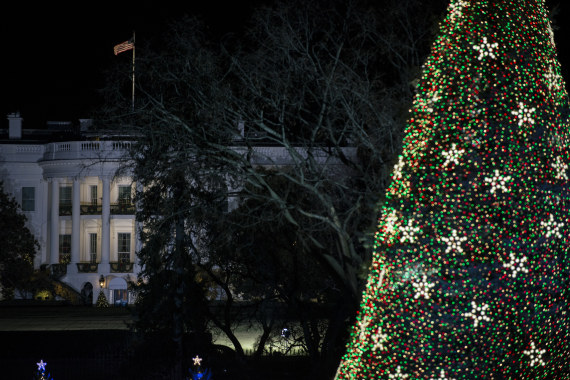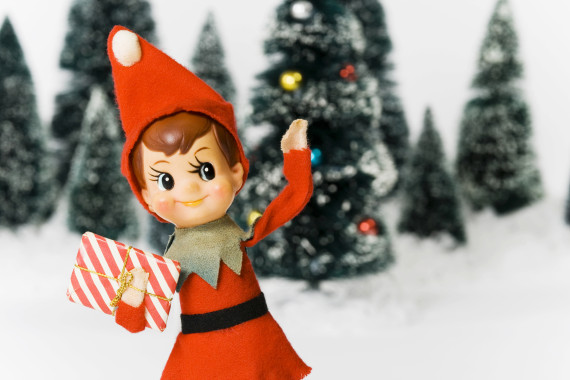Ho ho NO.
With all the myths and folklore that surround the Christmas season, it can sometimes be hard to determine what's true and what's total bull-mistletoe (that'll make sense below). Whether you're trying to be the best Santa Claus impersonator in the country, or you just don't want to be a total Krampus this holiday season, you should check out the Christmas facts below. At least they'll give something to talk about at your eggnog cocktail party.

Gift wrap as we know it today was accidentally discovered in 1917, when a pair of Kansas City, Mo. brothers ran out of red, green and white tissue paper at their store and needed something else to wrap their customers' purchases in. On a lark they decided to try wrapping the gifts in thin, fancy paper intended for lining envelopes. This decision ended up being a complete smash hit, so they began selling the paper by itself, selling out of their gift wrap rolls year after year. Eventually they decided to start making gift wrap their main business, and the brothers, J.C. and Rollie Hall, founded Hallmark. Today we spend around $2.6 billion annually on gift wrap.
This said, before the Hall brothers invented contemporary gift wrap, there were actually already customs for wrapping gifts in paper. The practice of gift wrapping may have started as early as the first century A.D. in Korea, while the practice of using fancy paper and lace comes from the Victorian era.

In ancient times, evergreen plants were used for winter decoration to remind people that "life" was still possible and would return in the Spring. This practice was often tied to worship, as the Egyptians did so with Ra and the Romans celebrated with their festival of Saturnalia. The translation of this tradition into the modern "Christmas Tree" began in the 16th century, when German Christians started placing decorated evergreens in their homes. Some say it's possible that the Protestant reformer, Martin Luther, was the first person to add lit candles to a tree (which later inspired Christmas lights when electricity came around) to try and recapture the beauty of stars twinkling between branches outside.
It took awhile for Americans to adopt the Christmas tree, and until around 1840, the trees were still seen as pagan symbols. It wasn't until a magazine spread came along in 1846 featuring Queen Victoria and her family (her husband was German) standing around a Christmas tree that the evergreens started becoming popular in the U.S. Perhaps unsurprisingly, Americans ended up taking the German tradition of short Christmas trees and super-sizing it into Christmas trees that went from floor to ceiling.

Early Puritanical America actually outlawed Christmas from 1659 to 1681 in Boston, although New York and Virginia still celebrated the holiday. After the American Revolution, the holiday went completely out of vogue, as it was seen as a British custom and even the non-Puritanical Americans wanted nothing to do with it. During the first Christmas under America's new Constitution, Congress met and remained in session. That seems almost laughable considering the holiday work schedule of today's Congress.
Christmas started to come back into favor slowly and eventually it received a boost from an author named Washington Irving. In 1806, he wrote a book called, "Dietrich Knickerbocker’s History of New York," which detailed the Dutch St. Nicholas and various Christmas traditions. In 1819, Irving wrote an even more popular short story book called, "The Sketch Book of Geoffrey Crayon," which included "Sleepy Hollow" and "The Legend of Rip Van Winkle," along with five Christmas stories. These new Christmas stories detailed different holiday traditions (such as caroling) that ended up becoming adopted in America. "A Visit From St. Nicholas," or as it's known now, "Twas the Night Before Christmas" was published in 1823 by Clement Clarke Moore and Americans haven't been able to resist the charm of Christmas ever since.

Ginger originated in Asia and might have made its way to Europe during the 11th century crusades. From there, Europe fell in love with ginger and turned it into gingerbread -- hosting "gingerbread fairs," turning it into shapes like animals, armor, or "gingerbread husbands," which women would sometimes eat to increase their chances of getting a mate. The Germans actually popularized the gingerbread cookie with their, "Lebkuchen," which led to the creation of the gingerbread house. And the likely inspiration? The witch's house made of candy in the German folktale of "Hansel and Gretel."

The earliest mention of December 25th being a holiday honoring the birth of Jesus is a Roman calendar from 336 A.D. This said, the Bible makes no reference to the actual date of Jesus' birth and the presence of shepherds with sheep suggest the possibility of a Spring birth, since the winter would be too cold for them to be out at night. It's commonly believed that the date comes from the Roman and pagan celebrations of Saturnalia, and that the early Christian church created the celebration of Jesus' birth as a sort of marketing ploy to win new converts. This would explain why Christians didn't celebrate the holiday over the first four centuries and really helps make sense of all the evergreens.
But in a differing view, it has been proposed that the winter date comes from an old Jewish calendrical belief regarding "great prophets" that would die and either be born or conceived on the same day. Under this theory, March 25th was calculated to be the day of Jesus' death by an early Christian writer named Tertullian, and so nine months later was declared Christmas Day. Regardless, the nine months would obviously be a rough estimate of when the actual birth was, so whichever side you believe, just know that December 25th is a bit of an arbitrary date.

While the Christmas elf was briefly mentioned in some early American literature, they weren't truly introduced into folklore until the mid-1800s and beyond. Louisa May Alcott (author of "Little Women") was the first to introduce the concept in writing with her 1850s book, "Christmas Elves," but that story was never published. The world had to wait until the 1873 Christmas issue of a magazine called, "Godey's Lady's Book," which featured a cover with Santa and "elves" among toys. The idea for Christmas elves came from European depictions of Santa which had been around for centuries and had helpers like the Dutch "Zwarte Piet." That said, Zwarte Piet was originally a slave in the Dutch narrative, and with the character customarily wearing black-face costumes, it seems the American Christmas elf was probably a huge improvement.

Baldur was the grandson of the Norse god Thor, and was terrified that every living plant and animal was out to kill him. While he trapped himself in his room and cowered in fear, his wife and mother begged for all the living things in the world to be nice to Baldur and to leave him alone. Problem is, they thought that asking mistletoe was pointless because it was so lowly. When they announced all had agreed, Baldur felt free of his fears and invited other gods to throw objects at him because they simply bounced off. Mischievous Loki then made an arrow from the wood of mistletoe and killed Baldur with it (earlier versions involved a mistletoe spear). We hang mistletoe above the door to never forget it and to remember the dangers of neglecting the "small things."
And if you're still feeling romantic about mistletoe - the word comes from the Anglo-Saxon words, "mistel" (dung) and "tan" (twig). It is believed to be named after what branches look like after birds have "left droppings."

There are a few popular myths that claim candy canes are a Christian candy, but this is not the case. One myth says there was an Indiana candy-maker who invented the candy cane in the shape of a "J" for Jesus (alternately a shepherd staff) and colored it white for the purity of Jesus' virgin birth and red for the blood shed on the cross. This story seems to be false, because candy canes appeared during the 17th century, which also debunks claims that the candies were used as secret identifiers for early persecuted Christians.
The closest possible religious connection that Snopes could find in unpacking this myth was a legend from 1670, alleging that the Christian Church appropriated an already popular Christmas candy -- originally in stick form -- and reshaped it as a shepherd staff to give to children at mass to keep them quiet.

Every year, biology professors at Harvard tell a Santa story that details a history of ancient shamans and reindeer eating psychedelic mushrooms together, which may have inspired the "flying" tale. The evidence is shaky, but according to NPR, biology professor Donald Pfister noted, "So here's a red fungus with white spots. And Santa Claus was dressed in red with white trim."
That said, scholars like John Rush, an anthropologist and instructor at Sierra College, believe the whole concept of Santa might come from these shamans. "As the story goes, up until a few hundred years ago these practicing shamans or priests connected to the older traditions would collect Amanita muscaria (the Holy Mushroom), dry them, and then give them as gifts on the winter solstice. Because snow is usually blocking doors, there was an opening in the roof through which people entered and exited, thus the chimney story," he said, according to NPR.
If you want to read more about this theory, check out the book, "Mushrooms and Mankind," which posits that Christmas traditions revolve around tress because "underneath the pine bough is the exact location where one would find this 'Most Sacred' substance, the Amanita muscaria, in the wild."

St. Nicholas was a Greek-Orthodox bishop who lived around 300 A.D. in what's now the nation of Turkey. Although he was known for his great generosity, the act that gave him sainthood and started the entire Santa legend came when he tossed a bag of gold coins through the window of an impoverished man who was being forced to sell his daughters into slavery (or potentially prostitution) in the morning. Because most saints were granted the title due to martyrdom at the time, this story of giving seemed to strike a profound level of human interest, which helped the respect for St. Nicholas survive the Protestant Reformation's efforts to destroy the celebration of all saints. Weirdly, the Reformation also caused people to bake gingerbread cakes in the shape of St. Nicholas, which might have been an important moment in the creation of gingerbread men.
But it was in the Netherlands' celebration of St. Nicholas (or in Dutch, Sinterklaas), that the Santa Claus we now know started fully materializing. Sinterklaas was adored in the Netherlands and Dutch writers introduced the concept of Santa coming down the chimney and flying over houses (although he did so on top of a horse). Santa began to take over America when the Dutch immigrants came to New York (originally called New Amsterdam) and celebrated his feast day. Eventually, Sinterklaas was named the "patron saint of New York" by Washington Irving, who as previously mentioned, was the catalyst for the popularization of Santa Claus in America.

Update: An earlier version of this article said the Dutch name for Santa Claus was Sinter Klaus while it is actually Sinterklaas. Sinter Klaus is the German version.

